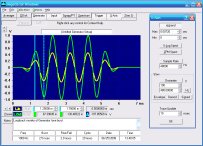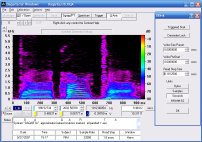![[LogoShip]](logo5.png)
Software for Windows
Science with your Sound Card!


Features:
Oscilloscope
Spectrum Analyzer
8-Channel
Signal Generator
(Absolutely FREE!)
Spectrogram
Pitch Tracker
Pitch-to-MIDI
DaqMusiq Generator
(Free Music... Forever!)
Engine Simulator
LCR Meter
Remote Operation
DC Measurements
True RMS Voltmeter
Sound Level Meter
Frequency Counter
Period
Event
Spectral Event
Temperature
Pressure
MHz Frequencies
Data Logger
Waveform Averager
Histogram
Post-Stimulus Time
Histogram (PSTH)
THD Meter
IMD Meter
Precision Phase Meter
Pulse Meter
Macro System
Multi-Trace Arrays
Trigger Controls
Auto-Calibration
Spectral Peak Track
Spectrum Limit Testing
Direct-to-Disk Recording
Accessibility
Data Logger
Waveform Averager
Histogram
Post-Stimulus Time
Histogram (PSTH)
THD Meter
IMD Meter
Precision Phase Meter
Pulse Meter
Macro System
Multi-Trace Arrays
Trigger Controls
Auto-Calibration
Spectral Peak Track
Spectrum Limit Testing
Direct-to-Disk Recording
Accessibility
Applications:
Frequency response
Distortion measurement
Speech and music
Microphone calibration
Loudspeaker test
Auditory phenomena
Musical instrument tuning
Animal sound
Evoked potentials
Rotating machinery
Automotive
Product test
Contact us about
your application!
Sound Card Amplitude Modulation (AM)
Macro: AMdlg
This button in the Modulation section of a Stream brings up the Amplitude Modulation dialog. It is shown depressed when AM is activated for this stream. The actual AM toggle button is at the top of the opened dialog.
AM Overview
Amplitude modulation is when the amplitude of one signal (the 'carrier') is controlled (modulated) by the instantaneous value of another (the 'modulator'). Adjusting a radio's volume control modulates the amplitude of the sound; here we are effectively replacing a hand on a knob with an automated process.
'Tremolo' in music is a form of amplitude modulation, although there may also be some attendant frequency modulation ('vibrato') with real-world instruments and voices. Tremolo typically involves a modulation rate of several hertz.
If the modulation rate is fast enough, you will hear the addition of new tones that aren't present in the carrier signal or the modulator. These tones are called 'sidebands', and you can easily see them with the Spectrum display. If the carrier and modulator are both sine waves, you will see two sideband components, one at the sum of the carrier and modulator frequencies, and one at the difference. The size of these sidebands is controlled by the amount of modulation, known as 'depth'.
If the modulator contains more than one frequency component, then each component acts independently with the carrier to produce sum and difference sidebands. For example, if the modulator is a band of noise from 100 to 200 hertz and the carrier is a sine wave at 1000 hertz, then the AM output will have an upper sideband from 1100 to 1200 hertz and a lower sideband from 900 down to 800 hertz. Note that the lower sideband is the mirror image of the upper sideband.
Each Stream allows a choice of modulation sources, either a dedicated sine wave or the output of another stream, which may be any waveform or noise source and include modulation of its own. You can change the frequency and phase of the dedicated source via controls in the AM dialog, whereas if you select a stream modulator you would adjust that other stream directly.
The AM Depth control adjusts the dedicated sine or any stream modulator. Note that if you are using stream modulation, the Level control on the other stream works in tandem with AM Depth here.
Macro Notes:
If the Stream dialog is open, AMdlg=1 opens the AM dialog, AMdlg=0 closes it, and AMdlg=x toggles between open and closed.
Note that you do not need to open the AM dialog to change any of its controls directly via macro command.
See also Amplitude Modulation Dialog, Waveform Stream Controls.
- Back to Burst Sine Modulator Phase
- Ahead to Amplitude Modulation (AM) Dialog
- Daqarta Help Contents
- Daqarta Help Index
- Daqarta Downloads
- Daqarta Home Page
- Purchase Daqarta
Questions? Comments? Contact us!
We respond to ALL inquiries, typically within 24 hrs.INTERSTELLAR RESEARCH:
Over 35 Years of Innovative Instrumentation
© Copyright 2007 - 2023 by Interstellar Research
All rights reserved